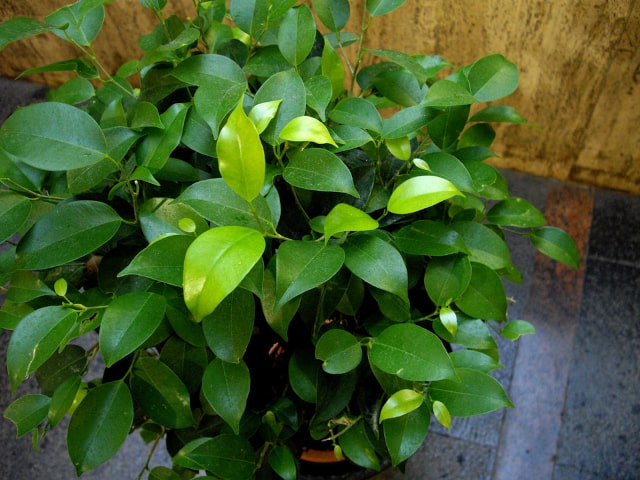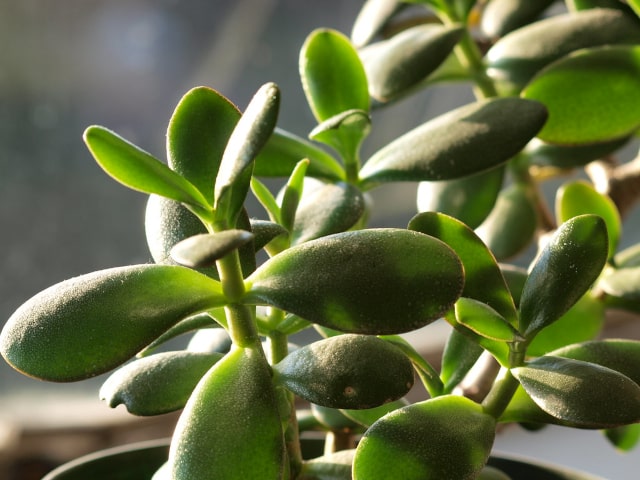
Ficus Benjamina, also known as the Weeping Fig, is an evergreen shrub you can grow in your home. This plant is native to Malaysia and other pasts of south-east Asia, as well as northern Australia and south-western Pacific. A great thing about this beautiful shrub is that it is very low maintenance, so even beginner gardeners can grow it. Ficus Benjamina can grow up 50 feet in height, and it is famous for its gorgeous dark green leaves.
There are several varieties you can grow in your garden as a green fence. These are particularly popular in tropical areas. If you live outside of hot areas, you should grow Weeping Fig inside of the home as a container plant. Another great thing about this plant is that it produces sweet, edible fruit twice per year.
If you want a truly eye-catching vatiety, opt for Ficus Benjamina "Starlight". This variety has a white frame on each leaf. Another great variety to grow in your home is "Golden Monique". This ficus has yellow leaves with a drop of green on top. Finally, those who prefer dark leaves should opt for "Midnight" variety, since it has dark green foliage.
Ficus Benjamina Blossom Time
You will know your ficus is in the blossom time because the tree will cover itself in small, pale yellow blossoms. These plants also produce edible fruit. This fig fruit can be eaten raw or it can be used in cooking. Keep in mind that all of the blossoms are female, so it means the tree pollinates itself. However, in order to yield properly, Ficus Benjamina need tropical pollinating wasps.
Keep in mind that not all Ficus Benjamina will yield fruit, particularly those that are kept indoors. However, many people report good results. If your Weeping Fig yields fruit, you can expect to have fruits twice per year.
Typically, the shrub will start blooming during its second or third year. Since Weeping Fig is a low-maintenance plant, there is not much you need to do to have it yield fruit. Once it starts giving fruit, a Weeping Fig plant will continue to do so for many years.
There are a few things you can do to encourage your plant to give fruit. Probably the most important thing is to keep it well-contained, so it doesn't waste its energy into growing too big. If you grow your Weeping fig outdoors, make sure to prune it s it won't grow too big. Pruning should be done after each active growth period is over. The best time to prune your shrub is from late summer to early winter. This will make your shrub look better, and it will be contained enough so it won't waste its energy into too much foliage. This energy should be invested in growing fruit.
Growing Ficus Benjamina Indoors
A great thing about Ficus Benjamina is that it can thrive indoors without much problem. In fact, this plant grows welly well indoors, which is great news for those who don't live in hot enough areas.
In order to make your Weeping Fig thrive inside, there are a few things to keep in mind:
- Ficus Benjamina can do great in a soil-based potting mix, but it will rarely grow larger than 10 feet in height. It means that your indoor Weeping Fig will always be shorter than the one grown outdoors.
- Ficus Benjamina is not likely to flower in the indoor conditions. And even if it does flower, it is not likely to produce fruit because there are no pollinating wasps.
- Your shrub requires just the right type of water. It has to be soft enough. Keep in mind that salts can easily kill your plant's roots.
- You should provide water to your plant every few days. Do it as soon as the surface gets dry. You should give your plant more water in the spring and summer. However, don't overwater it: too much water can cause root rot.
- It is OK to take your potted Weeping Fig outside to your patio or garden, if the temperatures are high enough. In general, make sure that the temperature is over 15 degrees Celsius.
- You have to choose the right spot inside of your home. There should be no draughts. If there is draught, your shrub will start dropping leaves.
- Make sure to prune your Weeping Fig once per year, during the later summer or early autumn. Keep in mind that shrubs can grow rapidly, so they have to be pruned.
Your indoor shrub is not likely to give fruit, but it can still be a great choice for a houseplant. It can also be very useful. Ficus plants filter the air in your home, so they are a great choice for potted plants. They are also low-maintenance, so you can gorgeous plants in your home even without a lot of time and effort. Their beautiful, glossy leaves will brighten up any room.
Weeping Figs also make great bonsai trees in the home. You can even shape them in different ways, even braid them if you like. To do this, make sure to plant trunks close together and braid them carefully. The stems will grow into each other and form a braid. This will produce a striking visual effect.
Photo credit: puamelia




0 Comments